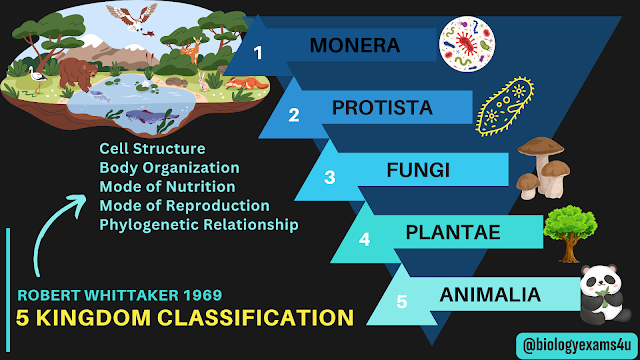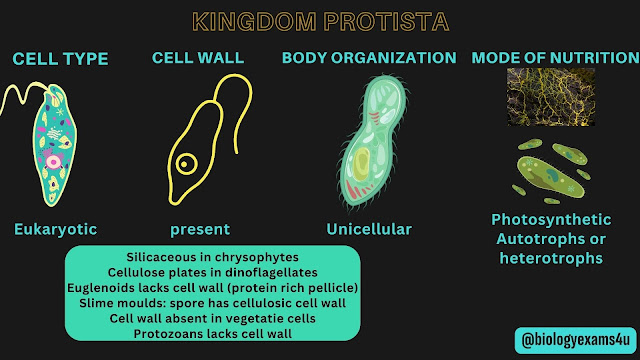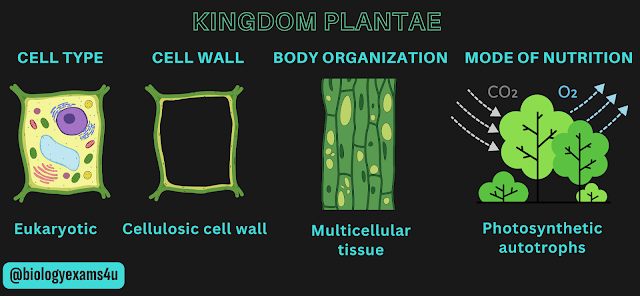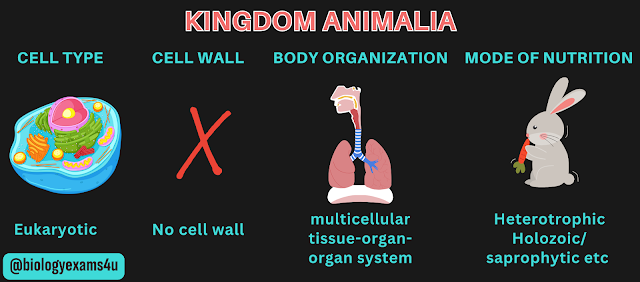The Five Kingdom Classification system was proposed by Robert Whittaker in 1969. He classified all living organisms into five distinct kingdoms based on their
- cell structure
- body organization,
- mode of nutrition
- mode of reproduction
- and phylogenetic relationship or evolutionary relationship among organisms.

The five kingdoms of life are Monera, Protista, Fungi, Plantae, and Animalia.
The first kingdom, Monera, consists of eubacteria, archaebacteria, cyanobacteria and mycoplasma. All are unicellular prokaryotes.
- Eubacteria, also known as true bacteria, are characterized by rigid non cellullulosic peptidoglycan cell wall. They are found in a variety of environments, including soil, water, and living organisms. Examples include E. coli, Lactobacillus etc.
- Archaeabacteria, also known as Archaea, are single-celled microorganisms that can be found in a wide variety of environments, including extreme environments such as hot springs, salt lakes, and deep-sea hydrothermal vents.
- The three main classes are Methanogens that produce methane gas and are found in anaerobic environments. Halophiles that are adapted to live in high salt concentrations and Thermophiles that can withstand extremely high temperatures.
- Cyanobacteria also called as blue green algae are a type of bacteria found in aquatic environments, capable of photosynthesis and fixing nitrogen. Some examples are Nostoc and Anabaena.
- Mycoplasma. Mycoplasma are a type of very small bacteria that lack a cell wall, making them unique from other bacterial species. Some are pathogenic to plants and animals.
Now let us discuss the characteristics of kingdom monera.
- They are prokaryotic, meaning they lack a nucleus and other membrane-bound organelles.
- Cell wall is non cellulosic, peptidoglycan in eubacteria and polysaccharides and glycoconjugates in archae.
- All are unicellular and simple in structure.
- Mode of nutrition is Autotrophic or heterotrophic.
Photosynthetic autotrophs use energy from light to convert water and carbon dioxide into glucose, Whereas chemosynthetic autotrophs use various inorganic substances like nitrates and ammonia to power their metabolic processes.
Heterotrophs cannot produce their own food and must obtain nutrients from other sources that is plants and animals.
Saprophytes are organisms that obtain their nutrition by breaking down dead or decaying organic matter.
Parasites obtain their nutrition by living on or inside another organism, known as the host.
The second kingdom, Protista, contains unicellular eukaryotic organisms. It consists of chrysophytes, dinoflagellates, euglenoids, slime molds and protozoans.
- Chrysophytes include diatoms and golden alage or desmids. They are are a group of unicellular or colonial microscopic planktons found in both freshwater and marine environments. They are the primary producers in the ocean.
- Dinoflagellaetes are photosynthtic protists, mostly marine, cheif producers in ocean. They are known for their ability to create a glowing effect in the water, known as bioluminescence, such as Gonyaulax which is responsible for red tide.
- Euglenoids are photosynthetic fresh water protists with pigments like chlophyll b, identical to that of higher plants.
- Slime molds are often plasmodial saprophytic protists. Some examples are Physarum and Stemonitis.
- Protozoans are heterotrophic protists either live as predator or as parasites. They are often motile with flagella or cilia. Some of the most well-known unicellular organisms include amoeba, paramecium, and Plasmodium.

Now let us undersatnd the characteristics of kingdom Protista.
- They are Eukaryotic, meaning with true nucleus and other membrane-bound organelles.
- Cell wall has Silica depositions in chrysophytes and arranged as Cellulose plates in dinoflagellates. Euglenoids lacks cell wall and has a protein rich pellicle as outer membrane. Slime moulds spore has cellulosic cell wall but Cell wall is absent in vegetatie cells. Protozoans lacks cell wall just like animal cells.
- All are unicellular with autotrophic or heterotrophic mode of nutrition.
The third kingdom, Fungi, includes multicellular organisms such as mushrooms, yeasts, and morels. This Kingdom include phycomycete, ascomycete, basidiomycete and deuteromycete.
- Phycomycetes are saprophytes or obligate parasites on plant. Mycelium is aseptate and coenocytic or multinucleate condition without a crosswall. Some common members include the bread mold Rhizopus, Albugo and Mucor.
- Ascomycetes are also called as sac fungi as sexual spores ascopores are produced inside sac like structure called ascus. Mycelium is well developed, branched and septate with conidia as asexual spores. They are saprophytic, parasitic or coprophilous meaning growing on dung. Examples include unicellular yeast, Aspergillus and edible Morels.
- Basidiomycetes the most diverse group of fungi with well developed spatate mycelium. Sexual spores called basidium are formed on specialized fruiting bodies aclled basidiocarp that includes mushrooms, puffballs, and brackets. Majority are saprophytes and some are parasites. Common examples include Agaricus (mushroom) and Puccinia that cause rust disease in wheat.
- Deuteromycetes are called fungi imperfecti as sexual reproduction is absent. They have septate mycelium and are either saprophytic or parasitic. Examples include Trichoderma and Alternaria.

- Fungi are Eukaryotic, multicellular organisms with cell wall made up of chitin.
- They are heterotrophic may be saprophtyes, parasites or symbiotic like lichens.
The fourth kingdom Plantae include multicellular chlorophyll bearing photosynthetic organisms. This kingdom include algae, bryophytes, pteridophytes, gymnosperms and angiosperms.
- Algae are a diverse group of aquatic, photosynthetic organisms that range in size from single-celled microalgae to multi-cellular giant kelp. They are the major producers. Some common membres include Spirogyra, Volvox and Sargassum.
- Bryophytes are nonvascular seedless plant—namely mosses, hornworts and liverworts.
- Pteridopohytes are vascular seedless terrestrial plants. Some common membres include Selaginella, Equisetum and Pteris.
- Gymnosperms inclde small shrubs to giant trees like giant red wood tree. They are naked seeded vascular plants. Examples of gymnosperms include Cycas and Pinus.
- Angiosperms are the most diverse and advanced group of plants. They are flowering plants which produce seeds and fruit.

Members of Plantae are Eukaryotic, multicellular organisms with cell wall made up of cellulose. They are photosynthetic autotrophs.
The fifth kingdom Animalia include multicellular heterotrophic organisms. Some of the Phylum include Phylum Porifera, Coelentrata, Annelida, Arthropoda and Chordata.
Let us discuss the key characteristics of some phyla.
- Phylum Porifera, also known as sponges, is a group of simple aquatic animals that lack true tissues and organs.
- Phylum coelentrata are aquatic animals, which show a very simple level tissue organisation like Hydra.
- Annelida also known as the segmented worms. They are a large phylum including ringworms, earthworms, and leeches.
- Arthropoda is the largest phylum of all living organisms and having members with characteristic exoskeleton and segmented bodies. Includes insects, spiders and crabs.
- Phylum Chordata a highly evolved group of animals that have a dorsal notochord at some stage of development; in most cases, this is the backbone. This phylum include fishes, amphibians, reptiles, birds, and mammals.

Members of Animalia are Eukaryotic without a cell wall. But with advanced level of multicellularity and tissue organization. They are heterotrophs with Holozoic nutrition a type of nutrition where organisms ingest solid food, digest it internally, and absorb nutrients for energy. Thank you so much.

